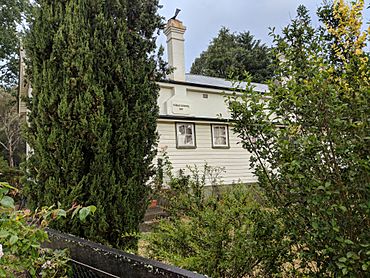Majors Creek, New South Wales facts for kids
Quick facts for kids Majors CreekNew South Wales |
|||||||||||||||
|---|---|---|---|---|---|---|---|---|---|---|---|---|---|---|---|

The former Majors Creek School, now a residence
|
|||||||||||||||
| Population | 249 (2016 census) | ||||||||||||||
| Established | 1851 | ||||||||||||||
| Postcode(s) | 2622 | ||||||||||||||
| Location | |||||||||||||||
| LGA(s) | Queanbeyan–Palerang | ||||||||||||||
| Region | Southern Tablelands | ||||||||||||||
| County | St Vincent | ||||||||||||||
| Parish | Elrington | ||||||||||||||
| State electorate(s) | Monaro | ||||||||||||||
| Federal Division(s) | Eden-Monaro | ||||||||||||||
|
|||||||||||||||
Majors Creek is a small village in the Southern Tablelands region of New South Wales, Australia. The nearest major town is Braidwood, 16 km (9.9 mi) to the north. At the 2016 census, the population of Majors Creek was 249. A former gold mining town, the settlement is today associated with the operational Dargues Reef gold mine.
It lies to the east of the Great Dividing Range, on high ground, near a watershed between the Shoalhaven River catchment and the Deua-Moruya River catchment. It is on the upper part of Majors Creek (the watercourse), a tributary of Araluen Creek and a part of the Deua-Moruya catchment. Nearby Back Creek and Jembaicumbene Creek are tributaries of the Shoalhaven River; 36km by road west of Majors Creek, Captains Flat is on the Molonglo River, a tributary of the Murrumbidgee, in the Murray-Darling catchment.
The area now known as Majors Creek lies on the traditional lands of the Walbanga people, a group of the Yuin. Probably due to reasons such as finding a viable means of sustenance, most of the surviving Aborigines living in the goldfields around Braidwood, migrated toward the coast—also Walbanga country—in the later years of the 19th-century. Local Aboriginal people were inhabiting the Majors Creek area, until at least the very early years of the 20th century.
After settler colonisation, Majors Creek lay within the Nineteen Counties that were open to settlement. Land was granted to Major William Sandys Elrington—'Mount Elrington', at nearby Farringdon —which was extended, in 1831. Although he may have used land around what is now Majors Creek for grazing, he seems not to have had title over that area. Around 1840, a settlement officially known as Elrington came into being; from the time of the first gold mining around 1851, it was better known as Majors Creek. Both these names stem from Major William Sandys Elrington.
Elrington had a 29-year military career, including service in the Peninsula War, before selling his commission, in 1826, and migrating to Australia, in 1827, and taking up a grant of land. Elrington sold his land and left Australia for good, in 1846; he, therefore, did not benefit from the discovery of gold, five years later.
Still officially known as Elrington, the plan of a town was laid out by surveyor W.E.Larmer, in 1858. The modern-day village's only commercial business, its hotel and post office agency is still known as the Elrington Hotel. The existing hotel was built in 1913, replacing an earlier hotel that stood on a site opposite to it.
Majors Creek had a school from 1857 to 1967. The old school building lies in a part of Majors Creek that was originally set aside as a small private town, known as Inkley.
In the 1870s, an Italian-born stonemason, Peter Rusconi, built the stone parts of the bridge over Major’s Creek (the one on the main road, on the way into the town) and St Stephen’s Anglican Church.
The town is also the venue for the biennial Music At The Creek festival.


